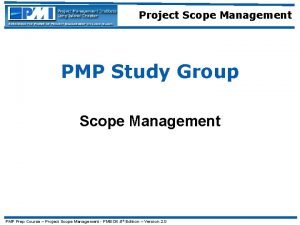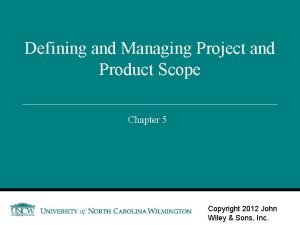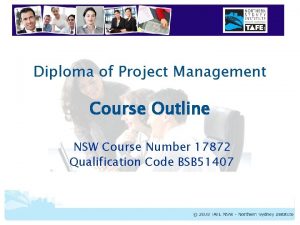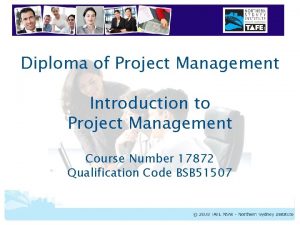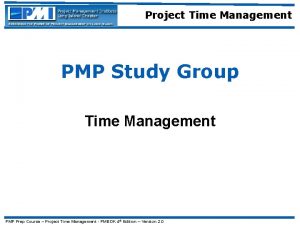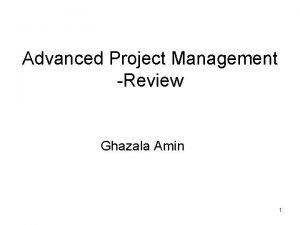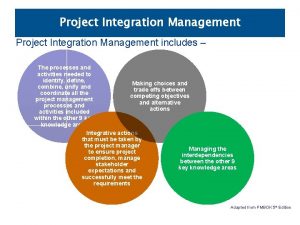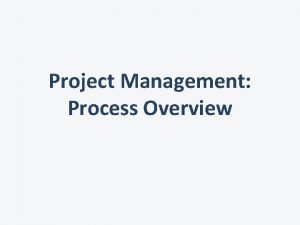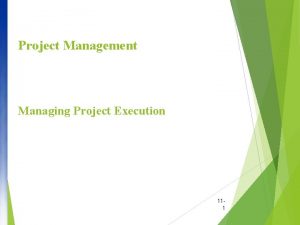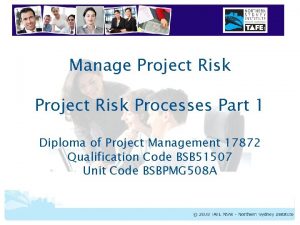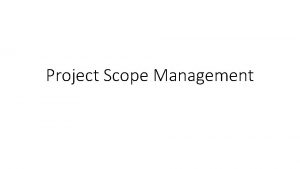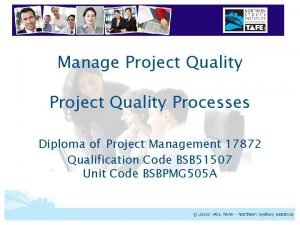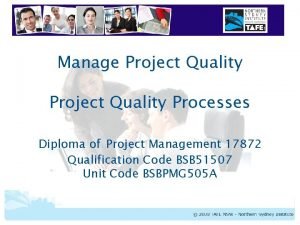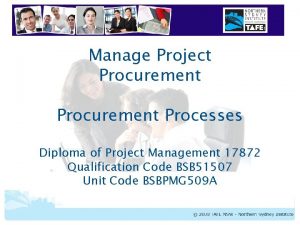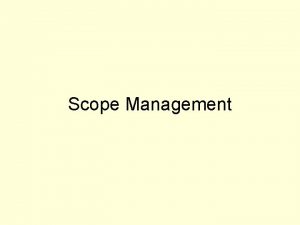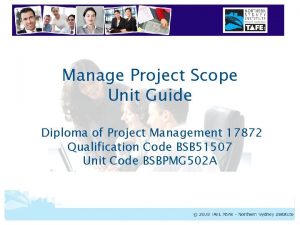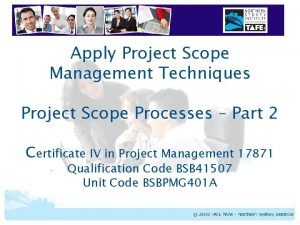Manage Project Scope Processes Diploma of Project Management











- Slides: 11

Manage Project Scope Processes Diploma of Project Management 17872 Qualification Code BSB 51507 Unit Code BSBPMG 502 A BSBPMG 401 A Apply Project Scope Management Techniques

Definition of Project Scope is – ü the work that must be performed to deliver a product, service or result as per the specifications or requirements ü concerned with what is included in the project and what is excluded from the project ü determined at a high level during the project initiation phase and expanded in the planning phase ü generally determined by the Project Sponsor, expanded by the Project Manager and then reconfirmed with the Project Sponsor ü defined by the boundaries or range for the project including constraints, assumptions and dependencies ü related to the objectives, outcomes, requirements Adapated from PMBOK 4 th Edition BSBPMG 401 A Apply Project Scope Management Techniques

What is a Project Sponsor? • The Project Sponsor is critical during the development of project scope and has a key role to play during project execution. • They are the person for whom the project is being undertaken and they will directly benefit from the deliverables and outcomes of the project. • The Project Manager needs to ensure that the Project Sponsor has approved the Project Scope so that there are no misunderstandings about the breadth and outcomes of the project. • The Project Sponsor is often a senior manager, customer or external client. BSBPMG 401 A Apply Project Scope Management Techniques

Importance of Project Scope Why is it important? üGives the Project Manager concrete goals üEnsures the objectives of the Project Sponsor are met üProvides the basis for expectation management, monitoring and reporting üDetermines the baseline against which project success can be measured BSBPMG 401 A Apply Project Scope Management Techniques

Ownership of Project Scope 1. Take some time to reflect on who owns the Project Scope 2. Consider the following specific questions – • Who owns Project Scope? • Who approves changes to Project Scope? • Who monitors Project Scope? • Who assesses impact to Project Scope? 3. Then go to the Forum on Project Scope Ownership and provide comment on the questions that are posed. Reflect Comment BSBPMG 401 A Apply Project Scope Management Techniques Debate

Characteristics of Project Scope • Poor control over project scope is one of the common reasons for project failure • Projects that never seem to finish are normally suffering from a failure to control scope • Project scope is defined at a high level during the early stages of the project and then progressively refined Refined during the project High level becoming detailed Assumptions often Constraints required will be applied BSBPMG 401 A Apply Project Scope Management Techniques Changes need to be monitored Measures project success

Project Scope Interrelationships Scope • Scope is related to Project Time, Project Cost and project Quality Time • Sometimes referred to as the ‘triple constraint’ Cost Quality • Scope expansion and contraction has flow on impacts to Time, Cost and Quality • Trade offs between all four relationships are possible BSBPMG 401 A Apply Project Scope Management Techniques

Project Scope Interrelationships Increased Cost Scope Increases when Time Fixed leads to and/or Additional Resources • If the project scope is increased when the project timeframe must remain fixed then normally the overall cost will need to increase as more resources are added in order to complete the additional work BSBPMG 401 A Apply Project Scope Management Techniques

Project Scope Interrelationships Extra Time Scope Increases when Cost Fixed leads to and/or Reduced Quality • If the project scope is increased and the project cost must remain fixed then normally the overall timeframe will need to be extended to allow extra time for the additional work to be undertaken (this assumes that there is no cost involved in extending the resources for a longer period). It may also be possible to compromise on quality in order to speed up execution so that no additional time is required, thereby reducing pressure on the budget. BSBPMG 401 A Apply Project Scope Management Techniques

Project Scope Interrelationships Reduced Time Scope Decreases lead to and/or Reduced Cost • When scope is decreased then it may be possible to reduce both the project cost and timeframe. Scope reduction is a common reaction to overall budget cuts within an organisation. BSBPMG 401 A Apply Project Scope Management Techniques

Next Steps Please proceed to Scope Processes Part 1 in the Learning Program. Best of Luck! BSBPMG 401 A Apply Project Scope Management Techniques
 Product scope vs project scope
Product scope vs project scope Use case diagram
Use case diagram Diploma in project management course outline
Diploma in project management course outline Dual diploma project management
Dual diploma project management Concurrent in os
Concurrent in os Time management pmp
Time management pmp Ghazala amin
Ghazala amin Project integration management
Project integration management Six processes of project integration management
Six processes of project integration management The management process consists of
The management process consists of Direct and manage project execution
Direct and manage project execution Bsbpmg508a
Bsbpmg508a
